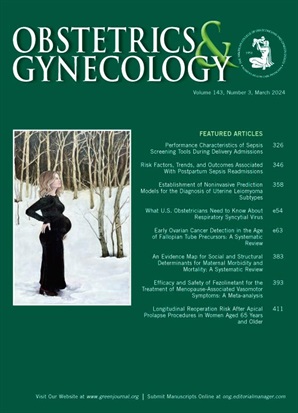Survival After Simple Compared With Radical Hysterectomy for Patients With Early-Stage Cervical Cancer.
IF 5.7
2区 医学
Q1 OBSTETRICS & GYNECOLOGY
引用次数: 0
Abstract
OBJECTIVE To assess the effect on overall survival of simple hysterectomy with lymph node staging compared with radical hysterectomy with lymph node staging for patients with early-stage cervical cancer. METHODS We conducted a retrospective cohort study of patients in the National Cancer Database diagnosed with early cervical carcinoma of 2 cm or smaller (stage IA1 with lymphovascular space invasion through IIA1, International Federation of Gynecology and Obstetrics staging) from 2010 to 2019. After 1:1 propensity score matching, we compared patients who underwent simple hysterectomy with lymph node staging and those with radical hysterectomy with lymph node staging. The variables used for matching were age, tumor size, race and ethnicity, lymphovascular space invasion, year of diagnosis, Charlson-Deyo comorbidity score, histology, and surgical approach. The primary outcome was overall survival at the end of follow-up. Secondary outcomes included 30-day readmission rate and 30- and 90-day mortality rates. RESULTS In total, 4,167 patients met the inclusion criteria, of whom 2,637 patients (63.3%) underwent radical hysterectomy and lymph node staging and 1,530 patients (36.7%) underwent simple hysterectomy and lymph node staging. After propensity score matching, 1,529 patients in each group were included. There was no statistically significant difference in overall survival between patients who underwent simple hysterectomy and those who underwent radical hysterectomy (hazard ratio 1.25, 95% CI, 0.91-1.73, P=.17). Subgroup analysis by histology, lymphovascular space invasion, tumor size, and surgical approach did not reveal statistically significant differences in overall survival according to hysterectomy type. The hysterectomy groups also did not significantly differ in 30-day readmission rate (4.6% vs 4.2%, P=.73), 30-day mortality rate (0.1% vs 0%, P=.14), or 90-day mortality rate (0.1% vs 0.1%, P=.93). CONCLUSION Patients with low-risk cervical cancer could undergo less radical surgery without a negative effect on their oncologic outcomes.早期宫颈癌患者单纯子宫切除术与根治性子宫切除术后的生存率比较
目的评估对早期宫颈癌患者进行淋巴结分期的单纯子宫切除术与进行淋巴结分期的根治性子宫切除术相比对总生存期的影响。 方法我们对2010年至2019年期间在美国国家癌症数据库中确诊为2厘米或更小的早期宫颈癌(国际妇产科联盟分期为IA1期,淋巴管间隙侵犯达到IIA1期)的患者进行了一项回顾性队列研究。经过1:1倾向评分匹配后,我们比较了接受淋巴结分期的单纯子宫切除术和接受淋巴结分期的根治性子宫切除术的患者。用于匹配的变量包括年龄、肿瘤大小、种族和民族、淋巴管间隙侵犯、诊断年份、Charlson-Deyo 合并症评分、组织学和手术方法。主要结果是随访结束时的总生存率。结果 共有4167名患者符合纳入标准,其中2637名患者(63.3%)接受了根治性子宫切除术和淋巴结分期,1530名患者(36.7%)接受了单纯子宫切除术和淋巴结分期。经过倾向评分匹配后,每组均纳入了 1,529 名患者。接受单纯子宫切除术的患者与接受根治性子宫切除术的患者在总生存率上没有明显的统计学差异(危险比 1.25,95% CI,0.91-1.73,P=.17)。按组织学、淋巴管间隙侵犯、肿瘤大小和手术方式进行的亚组分析显示,子宫切除术类型不同,总生存率差异无统计学意义。子宫切除术组在30天再入院率(4.6% vs 4.2%,P=.73)、30天死亡率(0.1% vs 0%,P=.14)或90天死亡率(0.1% vs 0.1%,P=.93)方面也无显著差异。
本文章由计算机程序翻译,如有差异,请以英文原文为准。
求助全文
约1分钟内获得全文
求助全文
来源期刊

Obstetrics and gynecology
医学-妇产科学
CiteScore
11.10
自引率
4.20%
发文量
867
审稿时长
1 months
期刊介绍:
"Obstetrics & Gynecology," affectionately known as "The Green Journal," is the official publication of the American College of Obstetricians and Gynecologists (ACOG). Since its inception in 1953, the journal has been dedicated to advancing the clinical practice of obstetrics and gynecology, as well as related fields. The journal's mission is to promote excellence in these areas by publishing a diverse range of articles that cover translational and clinical topics.
"Obstetrics & Gynecology" provides a platform for the dissemination of evidence-based research, clinical guidelines, and expert opinions that are essential for the continuous improvement of women's health care. The journal's content is designed to inform and educate obstetricians, gynecologists, and other healthcare professionals, ensuring that they stay abreast of the latest developments and best practices in their field.
 求助内容:
求助内容: 应助结果提醒方式:
应助结果提醒方式:


